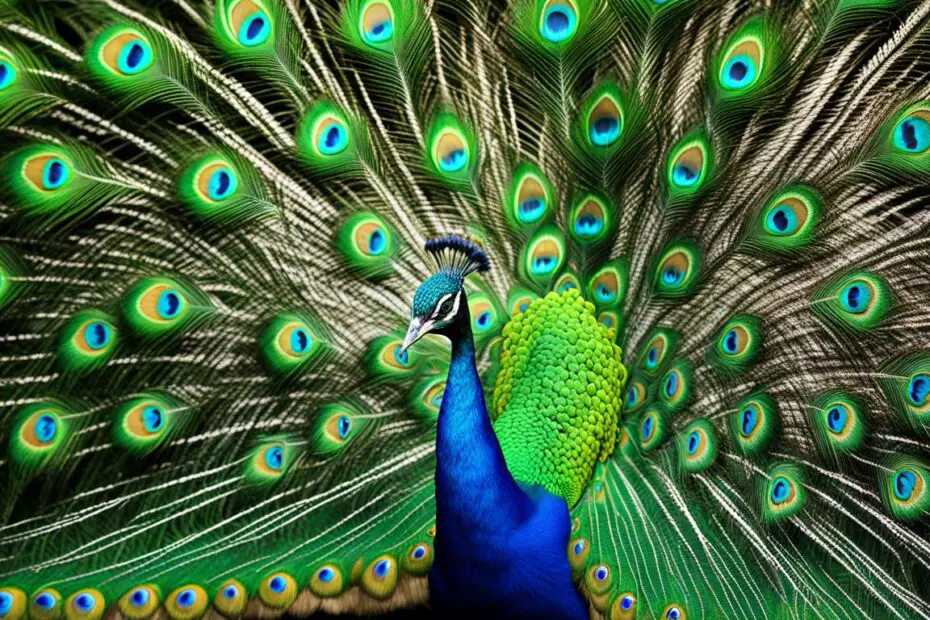Peacocks are renowned for their stunning tail feathers, vividly colored heads, and distinctive voices, making them unquestionably one of the most startlingly attractive birds in the world.
There are three unique species of Peafowl, and the United Peafowl Association acknowledges 225 distinct Peafowl species currently. Peacock color variations have developed through selective breeding and mutations, resulting in a wide range of colors, including blue, green, white, black, brown, yellow, and purple. Peafowls also exhibit different body patterns, such as pied, barred wing, white-eyed, silver pied, and black shoulder. Overall, the diversity of peacock color variations is a true testament to the nature’s artistic prowess.
Key Takeaways:
- Peacock color variations are the result of selective breeding and natural mutations.
- Peacocks display a wide range of colors, including blue, green, white, black, brown, yellow, and purple.
- Peafowls also exhibit different body patterns, such as pied, barred wing, white-eyed, silver pied, and black shoulder.
- The diversity of peacock color variations is a testament to nature’s artistic prowess.
- There are 225 distinct species of Peafowl recognized by the United Peafowl Association.
The Indian Peacock: A Marvel of Vibrant Blue and Green
The Indian Peacock, also known as the blue peacock, is the most recognized and endangered species of peacock. Native to India, Sri Lanka, and other countries in eastern Asia, this majestic bird showcases a breathtaking display of vibrant colors. The males, known as peacocks, proudly flaunt an astonishing tail plumage featuring stunning shades of blue and green.
These magnificent tail feathers are not just for show; they serve a crucial role in courtship rituals. During the mating season, peacocks spread their extravagant tail feathers into a stunning fan-shaped display to attract peahens, the female peacocks, and compete with other males. The bright blue heads and crest colorings of Indian peacocks further enhance their allure and make them a true wonder of nature.
While the males steal the show with their vibrant colors, female Indian peafowls, or peahens, possess a more subdued brown hue with green or blue heads. They also have smaller tail parts, which help them blend into their surroundings when caring for their young. The contrasting colors and patterns between male and female Indian Peacocks add to the visual splendor of this remarkable species.
Table: Indian Peacock Appearance
| Characteristic | Appearance |
|---|---|
| Gender | Male: Peacock Female: Peahen |
| Tail Feathers | Large, vibrant blue and green plumage |
| Head and Crest | Brilliant blue coloration |
| Body Color | Male: Bright blue and green Female: Subdued brown with green or blue head |
The Indian Peacock’s stunning coloration and impressive courtship displays make it an iconic symbol of beauty and grace. Its vibrant blues and greens serve as a testament to the extraordinary variations found within the peafowl family.
The Javanese Peacock: A Unique Green Beauty
The Javanese Peacock, also known as the green peacock, is a fascinating variation of this majestic bird. Native to the Indonesian island of Java, the Javanese Peacock showcases a distinct green hue in its head and crest, setting it apart from other peacock species. This unique green coloration is also exhibited by female Javanese peahens.
Similar to other peacocks, the Javanese Peacock engages in courtship rituals to attract mates. They use their large and vividly colored train feathers to display elaborate courtship dances, mesmerizing potential partners. While the train feathers of the Javanese Peacock may be similar to those of the Indian and green peacocks, its enchanting green color adds a unique touch to these captivating displays.
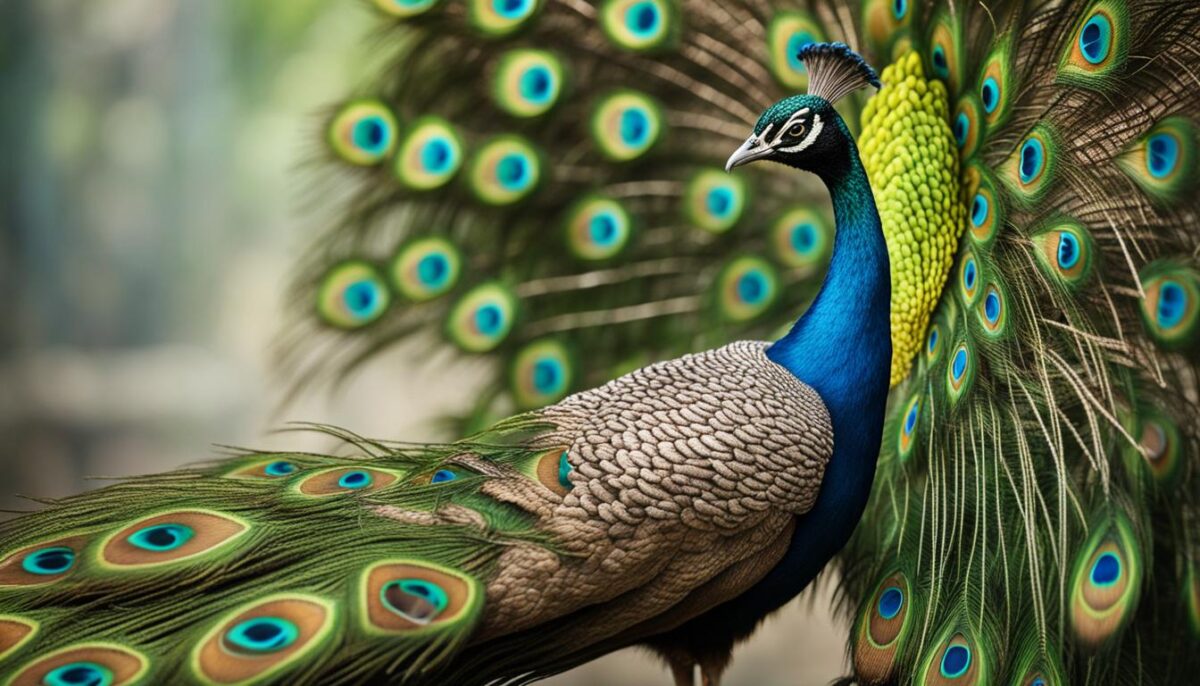
The Javanese Peacock’s courtship rituals and vibrant green coloration make it an extraordinary variation within the peafowl family. Its beauty and uniqueness have attracted the admiration of nature enthusiasts and artists alike.
The Congo Peacock: A Hidden Gem in Africa
The Congo Peacock is a fascinating and relatively unknown member of the peafowl family. Native to African countries, this species closely resembles regular pheasants in appearance. Unlike other peacock species, the males of the Congo Peacock lack the elongated, vividly colored tail feathers that are typically associated with peafowl. Instead, they boast a striking bright blue hue that covers their entire bodies. This unique coloration sets them apart from their Indian and Javanese counterparts.
On the other hand, the females of the Congo Peacock, known as peahens, display more earthy tones with mottled green and brown colors. This camouflaged plumage allows them to blend seamlessly into their natural surroundings. The combination of the male’s vibrant blue and the female’s understated colors creates a captivating contrast within the species.
The Congo Peacock is considered an endangered species and faces threats such as habitat loss and poaching. Conservation efforts are being made to protect and preserve this hidden gem of the African continent. Although much is still unknown about the Congo Peacock, its unique characteristics and endangered status make it a species worthy of attention and conservation.
The Congo Peacock at a Glance
| Scientific Name | Afropavo congensis |
|---|---|
| Family | Pheasant family (Phasianidae) |
| Native to | African countries |
| Males | Bright blue coloration |
| Females (peahens) | Mottled green and brown colors |
| Status | Endangered |
| Threats | Habitat loss and poaching |
Source: seowriting.ai
Peacock Colors: A Product of Selective Breeding and Mutations
Today’s peacock color variations have developed through selective breeding and natural mutations. The Indian and green peacocks serve as the two parental categories from which all other variations arise. For example, the white peacock is not an albino but rather a result of leucism, which causes a diminishment of skin and feather colors. The other breeding varieties include peacocks that are black, brown, yellow, and purple in color. These different colors are simply variations or mutations from the basic green or Indian peacock. Peacock feather colors contribute to the overall vibrant and colorful appearance of these majestic birds.
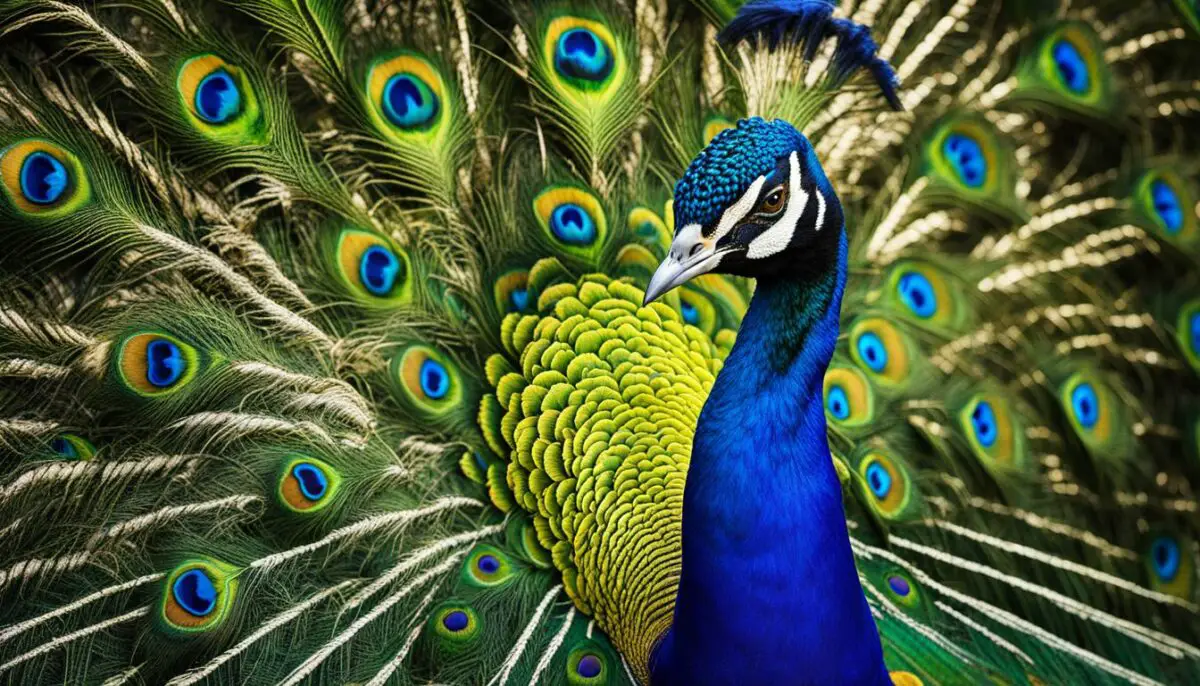
“Peacock colors are nature’s artistry at its finest, showcasing the incredible beauty that can be achieved through selective breeding and natural mutations. The stunning array of colors, from the vibrant blues and greens to the more exotic white, black, brown, yellow, and purple, is a testament to the ingenuity of nature. Each color variation adds to the overall splendor of these magnificent birds, making them a true feast for the eyes.”
The Role of Selective Breeding in Color Development
Selective breeding plays a crucial role in the development of peacock colors. Breeders carefully choose peafowls with desirable color traits and selectively pair them to produce offspring with the desired colors. Over time, these breeding practices have led to the establishment of distinct color variations, each with its unique charm and appeal. From the striking blue and green hues of the Indian Peacock to the elegant white and regal purple, selective breeding has allowed humans to play a part in shaping the color palette of these majestic birds.
Natural Mutations and the Emergence of New Colors
In addition to selective breeding, natural mutations have also contributed to the development of peacock color variations. Mutations occur spontaneously in the genetic makeup of peafowls, resulting in changes in their color genes. These genetic alterations can lead to the emergence of new colors not typically seen in wild peafowls. For instance, the stunning white peacock is the result of a natural mutation known as leucism, which causes a reduction in pigment production. The unique colors brought about by natural mutations add a touch of rarity and intrigue to the already captivating world of peacock colors.
| Peacock Color | Description |
|---|---|
| White | A result of leucism, causing a lack of pigmentation |
| Black | A rare color variation with deep, dark feathers |
| Brown | A warm and earthy coloration seen in some peafowls |
| Yellow | A vibrant and sunny color variation in peacock feathers |
| Purple | A rich and regal hue adding a touch of royalty to peafowls |
Peacock colors are the result of both human intervention through selective breeding and the mysteries of nature through natural mutations. Together, they have created a breathtaking spectrum of colors that continues to mesmerize and captivate all who behold the beauty of these magnificent birds.
The Richness of Peafowl Colors: A Palette of Fifteen Shades
Peafowls exhibit a stunning array of fifteen distinct colors, each contributing to the overall diversity and beauty of these magnificent birds. From the vibrant blues and greens of the Indian Peacock to the unique greens of the Javanese Peacock, each color variation showcases the extraordinary artistry of nature. Along with the more commonly known blue, green, and white peafowls, there are also bronze, opal, and purple peafowls that add even more richness to this colorful palette.
The visual impact of these colors is truly captivating, with each shade bringing its unique allure. The blue peafowl, for example, boasts a majestic royal blue hue that catches the light and shimmers with an iridescent sheen. In contrast, the green peafowl showcases a vibrant emerald green color that is equally enchanting. The white peafowl, with its pristine and elegant appearance, adds a touch of purity and elegance to the mix. And let’s not forget the mesmerizing opal peafowl, with its ever-changing array of shimmering colors that create a breathtaking spectacle.
The diversity of peafowl colors is not only visually stunning but also serves as a testament to the intricate beauty found in nature. The intricate patterns and shades found in the plumage of peafowls have long been a subject of fascination for artists and nature enthusiasts alike. These vibrant colors have inspired countless works of art and have become an iconic symbol of beauty and elegance.
| Peafowl Color | Description |
|---|---|
| Purple | A rich and regal color that exudes luxury and sophistication. |
| Blue | A vibrant shade of blue that catches the light and creates a stunning iridescent effect. |
| Green | An enchanting emerald green color that adds a touch of nature’s beauty. |
| White | A symbol of purity and elegance, the white peafowl embodies grace and serenity. |
| Bronze | A warm and earthy shade that adds a touch of rustic charm. |
| Opal | An ever-changing spectrum of colors that create a mesmerizing visual display. |
The richness and diversity of peafowl colors make them a true masterpiece of nature’s artistic prowess. Whether it’s the stunning blues, greens, and whites or the more unique shades of purple, bronze, and opal, the color variations found in these majestic birds never fail to captivate and inspire.
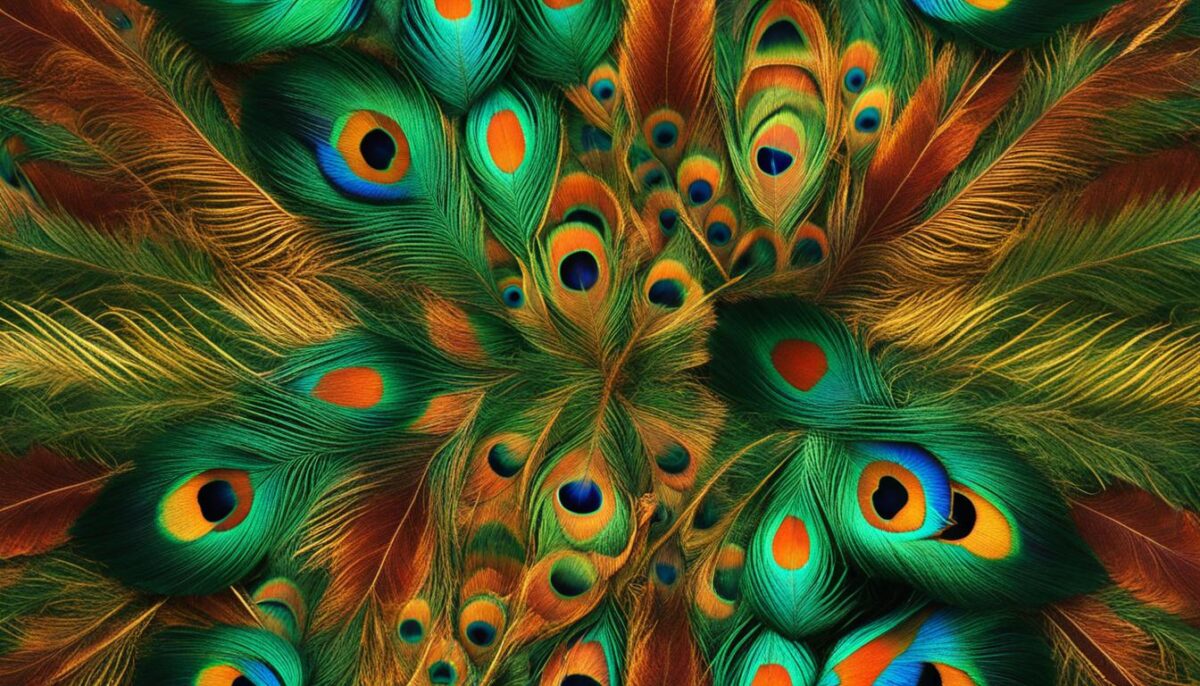
Popular Varieties of Peafowl: Spalding Peafowl and Black Shouldered Peafowl
Among the popular varieties of peafowl are the Spalding Peafowl and the Black Shouldered Peafowl. These unique peafowl variants showcase the diversity within the peafowl population, each possessing their own distinctive characteristics and beauty.
Spalding Peafowl
The Spalding Peafowl is a highly sought-after variety that is created by crossbreeding the Indian Peafowl and the Java Peafowl. This crossbreeding results in a larger bird with vibrant green neck and head colors, making it an exquisite addition to any peafowl collection.
There are several variations of the Spalding Peafowl, each with its own unique qualities:
- Spalding Pied: This variant displays the characteristic pied pattern, with a mix of white and colored feathers.
- Spalding White: As the name suggests, this variant has predominantly white feathers with hints of color on its neck and head.
- Spalding Cameo: The Spalding Cameo is distinguished by its soft, pastel-like colors, adding a touch of elegance to its appearance.
Black Shouldered Peafowl
The Black Shouldered Peafowl is another popular variety known for its striking features. The males of this species have black wings with a shimmering green and blue shine, creating a visually captivating display during courtship. The peahens of this species have cream-colored feathers with a subtle green sheen.
Both the Spalding Peafowl and the Black Shouldered Peafowl exemplify the beauty and diversity within the peafowl family, each showcasing their unique colorations and patterns.
| Peafowl Variant | Description |
|---|---|
| Spalding Peafowl | Created by crossbreeding Indian Peafowl and Java Peafowl, with vibrant green neck and head colors. |
| Spalding Pied | Displays a pied pattern with a mix of white and colored feathers. |
| Spalding White | Predominantly white feathers with hints of color on the neck and head. |
| Spalding Cameo | Features soft, pastel-like colors for an elegant appearance. |
| Black Shouldered Peafowl | Males have black wings with a shimmering green and blue shine, while peahens have cream-colored feathers with a subtle green sheen. |
- Spalding Peafowl: Crossbreeding of Indian Peafowl and Java Peafowl, with vibrant green neck and head colors. Variants include: Spalding Pied, Spalding White, and Spalding Cameo.
- Black Shouldered Peafowl: Males have black wings with a shimmering green and blue shine, while peahens have cream-colored feathers with a subtle green sheen.
The Spalding Peafowl and Black Shouldered Peafowl are just two examples of the captivating and diverse peafowl variations that continue to captivate bird enthusiasts and nature lovers alike.
Image source: https://seowriting.ai/32_6.png
Rare and Unique Peacock Types and Breeds
In addition to the well-known Indian, Javanese, and Congo peacocks, there are several rare and unique peacock types and breeds that showcase the extraordinary beauty of these majestic birds.
Bornean Peacock-Pheasant
One of the rarest and least known peacock species is the Bornean peacock-pheasant. This elusive bird is native to the rainforests of Borneo and is distinguishable by its intricate plumage and vibrant colors. The Bornean peacock-pheasant features a combination of iridescent blue, green, and bronze feathers that create a mesmerizing display.
White-Eyed Peafowl
The White-Eyed Peafowl is another unique variation of the peafowl family. As the name suggests, this breed is characterized by its striking white eye feathers, which contrast beautifully with its overall blue and green plumage. This rare peacock type is highly sought after for its ethereal and enchanting appearance.
Silver Pied Peafowl
The Silver Pied Peafowl is a visually stunning breed that boasts a distinctive silver and white plumage. This rare variation is a result of selective breeding and exhibits a combination of white, silver, and black feathers. The Silver Pied Peafowl is a true standout among peacock varieties, captivating onlookers with its regal elegance.
Opal Peafowl
The Opal Peafowl is a rare breed that showcases a unique opalescent coloration. Its feathers shimmer with a pearlescent sheen, reflecting a spectrum of colors as light hits them from different angles. The Opal Peafowl’s iridescent display is a breathtaking sight, making it a highly coveted and prized variety among peacock enthusiasts.
Burford Bronze Peafowl
The Burford Bronze Peafowl is an exquisite breed known for its rich coppery bronze plumage. This rare type exhibits a warm and lustrous color palette, with its feathers displaying a range of deep browns and metallic hues that create a sense of elegance and sophistication.
Cameo Peafowl
The Cameo Peafowl is a captivating breed that features a unique combination of creamy beige and soft pink feathers. This delicate coloration gives the Cameo Peafowl a soft and ethereal appearance, making it a prized variety among collectors and enthusiasts.
Purple Peafowl
The Purple Peafowl is a truly rare and remarkable breed with a stunning deep purple plumage. Its feathers shimmer and reflect shades of violet and royal purple, creating a mesmerizing visual display. The Purple Peafowl’s vibrant and regal coloration sets it apart as an extraordinary variation of the peacock family.
| Peacock Type | Description |
|---|---|
| Bornean Peacock-Pheasant | Native to Borneo rainforests, this rare species features a combination of iridescent blue, green, and bronze feathers. |
| White-Eyed Peafowl | Characterized by white eye feathers, this breed exhibits stunning blue and green plumage. |
| Silver Pied Peafowl | This visually striking breed boasts silver and white plumage, created through selective breeding. |
| Opal Peafowl | Featuring an opalescent coloration, this breed’s feathers shimmer with a pearlescent sheen. |
| Burford Bronze Peafowl | This breed showcases rich coppery bronze plumage, exhibiting deep browns and metallic hues. |
| Cameo Peafowl | With creamy beige and soft pink feathers, this delicate breed exudes a soft and ethereal appearance. |
| Purple Peafowl | This remarkable breed displays a stunning deep purple plumage with shades of violet and royal purple. |
These rare and unique peacock types and breeds add to the awe-inspiring diversity within the peafowl family. Each variation showcases a remarkable spectrum of colors, patterns, and distinctive features that make these birds true treasures of nature.
Peacock Color Variations in Art and Culture
Peacock color variations have not only mesmerized biologists and nature enthusiasts but have also found their way into the realms of art and culture. The structural coloration displayed by peafowls, which is the production of color by micro- or nano-structures that interfere with visible light, has fascinated artists and craftsmen across different cultures and time periods. The use of natural structurally colored materials derived from peacock feathers has been a common practice in various forms of art and craft.
Ancient Egyptians, for example, incorporated crushed elytra of buprestid beetles, which featured iridescent colors similar to those of peacock feathers, to decorate objects. The jewel beetle elytra has also been used by tribes like the Karen people in Burma and Thailand as embellishments in their daily life. These examples highlight the cultural significance and appreciation of peacock color variations.
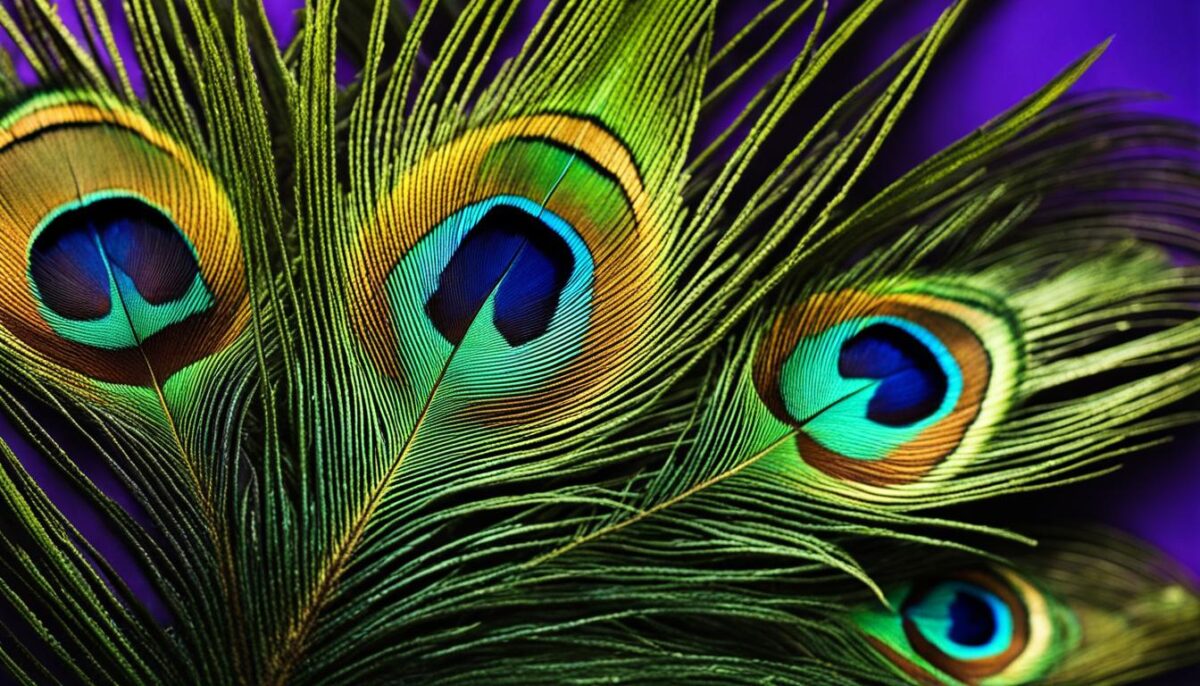
The Edges Course: Enhancing Artistic Expression
The Edges course is designed to provide artists with a comprehensive understanding of edges and their application in sketching. This course covers various techniques and strategies for capturing edges, including observation, line work, and shading. Through practical exercises and step-by-step instructions, artists can develop their ability to depict the intricate details and vivid colors of peacock color variations.
- Learn to observe and analyze edges in peacock feathers
- Master line work to define and accentuate edges in sketches
- Explore shading techniques to create depth and dimension in color variations
- Experiment with different mediums and tools to achieve desired edge effects
Whether you’re a beginner or an experienced artist, the Edges course offers valuable insights and techniques to enhance your artistic expression. By understanding the importance of edges in capturing peacock color variations, you can create stunning and realistic representations of these magnificent birds.
Unleash Your Creativity with the Edges Course
“The Edges course has transformed the way I approach sketching. I now have a deeper appreciation for the significance of edges in capturing the intricate beauty of peacock color variations. This course has allowed me to unleash my creativity and create artwork that truly reflects the stunning diversity of peacocks.” – Amanda, Artist
Unlock your artistic potential and explore the world of peacock color variations with the Edges course. Develop your skills in capturing edges, and elevate your artwork to new heights of beauty and realism. Discover the awe-inspiring artistry of nature through the intricate details and vibrant colors of peacock feathers.
Conclusion
Peacock color variations are a true testament to the artistic wonder of nature. The incredible diversity within the peafowl family is showcased through a wide range of colors, including vibrant blues, greens, whites, blacks, browns, yellows, and purples. These variations have been developed through selective breeding and natural mutations, resulting in 225 different types of peafowl. The unique body patterns, such as pied, barred wing, white-eyed, silver pied, and black shoulder, further contribute to the overall beauty of these majestic birds.
Peacock color variations have not only captivated the natural world but also found their way into art and culture. Across various cultures and time periods, artists and craftsmen have incorporated the stunning hues of peacocks into their creations. The use of naturally structurally colored materials, such as crushed elytra of buprestid beetles or jewel beetle elytra, showcases the universal fascination with these exquisite colors and patterns.
In the realm of art, understanding the importance of edges is vital in capturing the intricate beauty of peacock color variations. By focusing on edges, artists can depict the changes in plane and changes in color, enhancing depth and realism in their representations. The exploration of edges in sketching techniques allows artists to truly capture the awe-inspiring artistry of peacock color variations.
FAQ
What are the different species of peafowl?
There are three unique species of peafowl: Indian Peacock, Javanese Peacock, and Congo Peacock.
How many peafowl species are acknowledged by the United Peafowl Association?
The United Peafowl Association acknowledges 225 distinct peafowl species currently.
How do peacock color variations develop?
Peacock color variations develop through selective breeding and natural mutations.
What are the popular varieties of peafowl?
Some popular varieties of peafowl include the Spalding Peafowl and the Black Shouldered Peafowl.
What are some rare and unique peacock types and breeds?
Some rare and unique peacock types and breeds include the Bornean peacock-pheasant, White-Eyed Peafowl, Silver Pied Peafowl, Opal Peafowl, Burford Bronze Peafowl, Cameo Peafowl, and Purple Peafowl.
How have peacock color variations been incorporated in art and culture?
Peacock color variations have been used as naturally structurally colored materials in art and craft across various cultures and time periods.
What is the importance of edges in capturing peacock color variations?
Understanding the concept of edges in sketching helps to depict the intricate and vibrant colors of peacocks.


